Kategorie: ‘Molecular and Applied Biotechnology (MA)’
Writing a master’s thesis at TU Delft
- Molecular and Applied Biotechnology M.Sc.
- Netherlands, Delft
- TU Delft
- 05/2023 – 10/2023
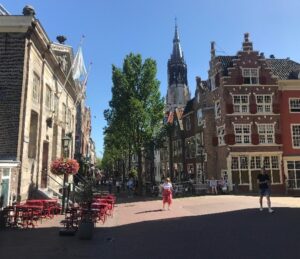
A street in the city centre of Delft (weekday), with the Nieuwe Kerk in the background.
© Raoul Liepelt
I wanted to do my master’s thesis abroad and therefore applied at a few universities across Europe. Applying at TU Delft, I noticed that there was no need to be shy, as they were very friendly, helpful and quick at replying to my e-mails. You can simply write to the research group leaders directly, introducing yourself, and stating that you are interested in doing a thesis with them and why (with attached CV and grades of course). At the section I applied to, the section of Bioprocess Engineering, they even have a standardized procedure. I ended up working on Microbial Electrosynthesis, which is a topic that I did not know that much about before coming to Delft.
I was lucky enough to receive university housing with Duwo. They are by far the cheapest and easiest option if you can get a flat with them. If you do receive housing by them and your flat is dirty upon entry, make sure to immediately complain directly to them. This was my mistake, as I complained to the university and therefore did not achieve anything and had to spend several days cleaning my flat by myself, which was extremely dirty.
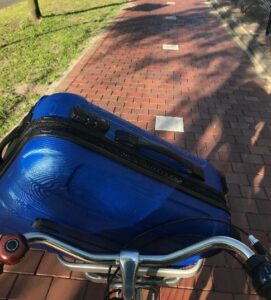
Doing everything by bike and public transport: The Netherlands make it possible
© Raoul Liepelt
From what I have heard from other students, this is not common, but can sometimes happen. However, the rental market in the Netherlands and especially Delft is very bad, so this is still your most financially affordable option. Otherwise, I can recommend trying for flat shares on kamernet etc. Do note that knowing a bit of Dutch might be a heavy asset.
In my section at TU Delft, I thoroughly enjoyed the working culture, which was a bit different compared to what I was used to.

The modern train station with one of the largest roads for cars of Delft and a bicycle path in front of it
© Raoul Liepelt
Hierarchies were much flatter and more collegial, and everybody at the section had their breaks together, even most of the professors. A lot of my colleagues were internationals and from different backgrounds, and I could always find someone to talk to about problems I was facing in my research or in general. Whether it was in post-lab
barbecuing sessions, having international treats, or watching Barbenheimer, I greatly enjoyed my time there and I miss all of the wonderful people I got to know in the section already.
Delft, like a lot of Dutch cities, is a greatly designed and beautiful little city that makes getting around by bicycle not just trivial, but natural. It is indescribable unless you experience it for yourself. Because of the lack of cars, the city is really quiet and cozy, even in the bustling centre. For me, getting around or exploring the area by bicycle never got old, even though I never cycle here in Germany.
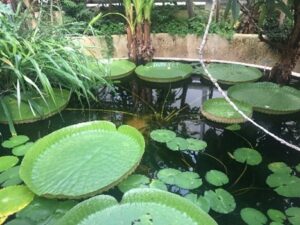
Exotic plants at the botanical garden of TU Delft.
© Raoul Liepelt
Delft is also extremely well connected by efficient public transport to other major Dutch cities, such as The Hague (with the beach at Scheveningen), Rotterdam, Leiden, Haarlem, or Amsterdam, so I can heavily recommend making trips to these places if you are there. For this, I would advise you to get a personal OV-chipkaart as one of the first things that you do when you arrive. It makes taking public transport much easier and cheaper if you take out a subscription,
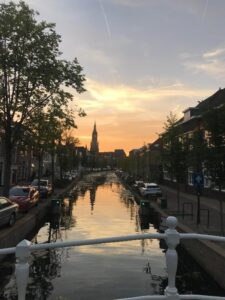
Good-bye Delft! Sunset over the Nieuwe Kerk.
© Raoul Liepelt
which I can also recommend.
To my surprise, it is possible to rent canoes and go on a ride in the canals of Delft, which was amazing to do. Delft also hosts a large amount of small shops, cafés and restaurants that were really lovely to explore, and I always asked the locals which ones were best for my needs, and they were happy to provide me with plenty of tips. If you are there in early-mid spring, you can check out the tulip gardens at Keukenhof, which are really lovely and colourful, even if they are a bit full at times. Lastly, the TU Delft botanical garden is definitely worth checking out, and it is free if you are at TU Delft.
All in all, I can heavily recommend the Netherlands and Delft in particular. If you happen to be interested in Bioprocess Engineering, give the section I was in a try! My Erasmus money went entirely to my rent and was therefore essential in financing my stay in Delft. I am really thankful that I was granted this opportunity!
Writing a master thesis in Norway
- Molecular and Applied Biotechnology M.Sc.
- Norway, Longyearbyen
- UNIS Svalbard
- 06/2023 – 04/2024
Application/Finding an Internship
The EU project FACE-iT is an international collaboration among several research institutions aimed at studying climate change in Arctic fjords across various trophic levels. Upon discovering the project online, I came across a thesis topic advertised on their website and promptly contacted the responsible professor. Following an online interview, I received confirmation of the suitability of the master thesis project. While the university regularly advertises thesis topics on their website, it’s also beneficial to reach out directly to professors to explore potential topics. Fortunately, I had previous experience with many professors at the University Centre in Svalbard (UNIS) due to my highly recommended bachelor exchange semester there.
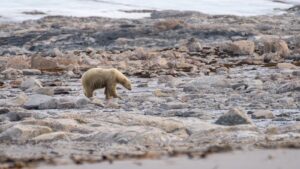
© Lina Lettau
Accommodation & Living Expenses
As a UNIS student, you are automatically allocated housing in the student dormitory, managed by Samskipnaden. Applications can be submitted through their website, offering various options, including a single room with a shared kitchen for approximately 10 people (510€), sharing a room with one other student, or one to two-person apartments with individual kitchens. Living expenses in Longyearbyen are on par with mainland Norway, making them approximately double the cost of living in Germany. The local supermarket impressively stocks a wide range of fresh fruits and vegetables for those who can afford them.

© Lina Lettau
Given the town’s small size, there aren’t many other ways to spend your money (except for drinks at one of the four bars), so most of my expenses went towards food and outdoor equipment.
Everyday Life/The Internship
My internship focused on marine molecular ecology, leading to a varied daily routine. This ranged from boat samplings in the summer to molecular lab work in the autumn, and data exploration during the polar night. Fieldwork days can be quite extensive from my experience. Nevertheless, the average Norwegian workday appeared to be a standard 9 to 5, except when the skies cleared after an extended period of overcast weather. In such cases, the department would empty as everyone ventured out for skiing or hiking. In terms of social life, if you come to Longyearbyen thinking you’re at the end of the world and should lead a hermit-like existence, think again. You’ll be living in student housing with approximately 200 people, and activities like hikes, ice climbing, skiing, snowmobile tours, games, dinner parties, knitting, puzzles, and movie nights are popular. Weekends were often spent in rural cabins outside of town.
Free Time/Tips
Two months before:
Ensure your passport is up-to-date. No visa is required, but you’ll be traveling outside of the EU.
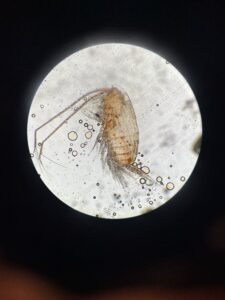
© Lina Lettau
Book your flights with SAS or Norwegian; if you’re under 26, they offer youth discounts.
Apply for a certificate of good conduct (Fuehrungszeugnis) in English and bring it with you. Guns are carried for polar bear protection outside of town, and you’ll receive rifle training upon arrival (no prior experience needed).
Two weeks before:
Stock up on items that might not be available or could be expensive in the one and only super market Longyearbyen. For me, this included tea, dried soy and seitan, drawing supplies, batteries, tech equipment, toiletries, fairy lights, analog photo films, guitar strings, and hair scissors.
Join all relevant Facebook groups, as Longyearbyen heavily relies on them. The most important ones include Ros & Info Longyearbyen (providing information on ongoing events and occurrences in town), Kjøp/salg/bytte/gi bort – Longyearbyen (an online second-hand marketplace), and Svalbard studies spring/autumn semester 20XX (with “XX” representing the year, depending on when you are here).
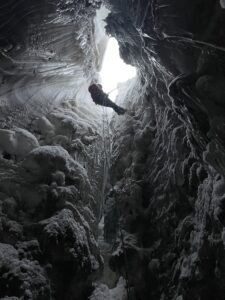
© Lina Lettau
Upon Arrival:
Explore Bruktikken, a donation-based free shop with a diverse range of items, including clothing, books, equipment, decoration, electronics, and more. You can even find second-hand bedsheets and towels there, so don’t overpack. Pro-tip: Work there and sort through the latest donations for yourself while earning money.
Become a member of Svalbard Turn to access the gym, swimming facilities, climbing, and various social sports.
Attend Sprakcafe on Mondays in the library to practice Norwegian while mingling with locals in town.
I also warmly recommend thoroughly reading the UNIS website section on Arrival and living in Longyearbyen – UNIS.
Conclusion:
My research experience at UNIS in Longyearbyen was a valuable opportunity that deepened my understanding of climate change in the unique Arctic ecosystem of Svalbard. Natural sciences and the great outdoors converge in a way that few other places on earth offer.
Internship in Oslo
- Molecular and Applied Biotechnology, M.Sc.
- Norway, Oslo
- Universitetet i Oslo
- 05/2023 – 07/2023
After looking for some alternatives outside the EU, I decided to search for an internship position in the EU and apply for the Erasmus+ funding. This was was with comparably few preparation time and less bureaucracy possible. To find an internship position, i visited the websites of universities I found interesting and searched for departments that work on topics that are interesting to me. I did not search for specific open position, but just wrote short formless mail to the professors or group leaders, introducing me and stating my interest. This worked very well and I had to contact less than five research groups to find an interesting project.
To find a place to live, I took a look at the offers from the University. In Oslo, this is SIO. They care for student cafeterias, housing, and do even have a fitness studio. The hosing application was simple and is worth a try. Even if you might be not quite sure, in which category of applicant you belong, you can ask them or also try what sounds best to you. The people there were very friendly and everything was very uncomplicated. For me it was important to live in a shared flat, because this makes meeting new people much easier and you will never be alone. Living expenses are indeed like everyone says more expensive than in Germany, but regarding the inflation in Europe and the the weak exchange rate of the Norwegian krown at the time, normal groceries were not too much more expensive.
I lived together with other students, mainly from Italy and one person from Germany, that made an Erasmus semester in Oslo. The dormitory was full of Erasmus students and it was easy to meet new people. Unfortunately, I arrived at the end of the Semester and most other students left after my first of three month. If possible, it might be an asset to plan you stay according to the semester start in you city of destination as then are much more social activities.
I travelled to Norway by car, what made it possible to carry a bicycle with me. But travelling by Train and Ferry or by Plane also works very well. For the mobility in Oslo, I can highly recommend to either bring a bicycle with you from home, or buy a cheap one in Oslo. Public transportation in excellent in Oslo, but also expensive, especially if you do not have a student status. By bike you are much more flexible and see much more of the city.
In the Institute I worked, the working atmosphere was very nice and welcoming. As a student I was invited to all meetings and free time activities, but never felt forced to participate anywhere. The first part of the Internship was very relaxed and some things did not work right away, but my supervisors were very supportive and always helped me when necessary. They also handled the pressure very healthy in the final part of the internship. I did work a lot in the last weeks, but this decision was left free for me and I was not set under pressure by my supervisors.
All in all, my Internship was a very enriching experience. I made my internship in a field I was so very proficient in before. This made it quite challenging for me, but on the other hand I feel like I have learned an incredible amount of things during these three month.
I planned to do some vacation after the internship and my supervisors helped me to plan the submission so that this is possible.
My master thesis in Denmark
- Molecular and Applied Biotechnology, M.Sc.
- Denmark, Greater Copenhagen
- Technical University of Denmark
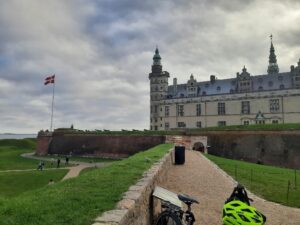
The Shakespeare caste in Helsingør, a nice destination for a day trip on the bike.
© Rebekka Horstmann - 10/2022 – 05/2023
To complete my master’s in biotechnology I was looking for a master’s thesis abroad and the Novo Nordisk Foundation Center for Biosustainability (CfB) at the Technical University of Denmark came to my attention. Denmark is well known for its thriving biotech sector and the center convinces with a strong focus on delivering more sustainable solutions for our society.
Finding accommodation in Greater Copenhagen can be challenging since not only the rent but also the deposits and prepaid rents can be a deterrent. However, student housing is in part also applicable for master thesis students at the accommodation office of DTU. While renting a studio apartment in a dorm is not necessarily the cheapest option, it makes flat hunting easier. Another common practicality is to have the moving-out date a couple of days, for example 10 working days, before the end of the lease, which is good to keep in mind.
During my stay at CfB, I was seated in an office with other master’s students, PhD students, research assistants, and a fermentation engineer which was a great chance to get very diverse input to the questions and challenges that came up along the way. In general, I experienced fairly flat hierarchies, and the openly designed workspace allowed for a lot of fruitful scientific discussions. As mandatory for an external thesis, I found examiners in Aachen before I started my project and had supervisors at the external institution. I was lucky to experience very supportive and thoughtful supervision which allowed me to develop a broad skill set. Fortunately, a Symposium was hosted at DTU on my last day, giving me the chance to present my findings on a poster and to get additional input.
Since DTU is a campus university, a lot of activities are offered in very close proximity. Therefore, it is easy to meet some other people during sports causes even with a full experimental schedule. Another part of the Danish work culture is the concept of “Friday bars”. In my center, the Friday bar was held once a month and was basically everyone gathering with a beer or soda in the canteen during the afternoon. That created a very relaxing atmosphere and gave a lot of opportunities to get to know your colleagues besides work topics as well as people from other research groups.
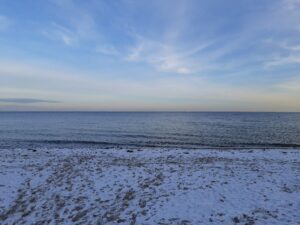
Skodsborg beach during the ice bathing season.
© Rebekka Horstmann
While written Danish is maybe not impossible to understand as a German-speaking person, spoken Danish can be quite tough. However, once you are registered in the civil registration system (and have a CPR number), the Danish government offers language courses in exchange for a deposit only. These courses are a great opportunity to meet other international students from different disciplines, have fun in practicing all the sounds in the Danish language, and of course, learn some basic Danish.
Regarding free time activities I can highly recommend to either bring or rent a bike. All across Zealand, there is a quite good network of bike lanes which is perfect to take a day trip to one of the many castles such as the so-called Shakespeare castle in Helsingør. It is also very convenient to explore the inner city of Copenhagen by bike and in most cases, you can even take it on public transport for free. As soon as the temperatures drop, you can see a lot of Danes going for an ice bath at one of the beaches which I can highly recommend giving a try.
My experiences in Oslo
- Molecular and Applied Biotechnology (MA)
- Norway, Oslo
- University of Oslo (UiO)
- 01/10–30/11/2022
I completed a two-month research internship at the Department of Biomaterials of the University of Oslo (UiO). In the following, I would like to tell you about my experiences before and during my stay.
Finding an internship and an accommodation
Although my home university, RWTH Aachen University, does not have an Erasmus partnership with UiO, I came into contact with the institute through my student assistant supervisor, who completed his Bachelor’s thesis there. After a lot of back and forth about the date and topic of the internship, writing a project plan and applying for accreditation of the internship at my home university, the big challenge of finding a place to live began. Unfortunately, my application for student accommodation with SiO, the student organisation in Oslo, was rejected – probably because of my short period of stay – and I had to look for accommodation on the private market. I sent many requests on finn.no and hybel.no, most of which I didn’t even get an answer to, but in the end I had found a room in a 2-person shared flat and nothing stood in the way of my internship. To get there, I decided to go green and first took the train to Copenhagen, where I had a one-day stopover, and then continued by Flixbus through Sweden to Oslo.
The internship and my working environment
My workplace was the Department of Biomaterials at the Institute of Clinical Dentistry, which is part of the University of Oslo. It was essentially a research laboratory of the dental clinic, and most of the research conducted there had to do with dental implants in the broadest sense. I was warmly welcomed and integrated into the team from day one. We were an international research group with a few Norwegians and many scientists from all over the world. Apart from me, there were two other interns, a German and an Italian, and both were Master’s students just like me.
Compared to my experiences in Germany, the hierarchies at our institute were quite low and hardly noticeable, and social interaction was very important: Not only did we have lunch together every day, but we also had many nice conversations, especially on the days when someone had brought a cake or something typical from their home country after visiting or receiving visitors. Sometimes we also organised social events – for example, an international lunch on United Nations Day on 24 October: Everyone was assigned a country from which they had to cook and bring something typical. My country was Tanzania and I made vitumbua (coconut rice pancakes), a popular street food. Before Christmas, socialising became even more important, so on the last day of my internship, I sat in the lunch room with my supervisor, my professor and some other colleagues and folded paper Christmas stars while eating homemade gingerbread.
Although the working atmosphere was quite relaxed, we not only took breaks and drank coffee (which, by the way, was free for all employees, including interns), but also worked in the lab and were very productive in conducting experiments. My project was about validating a method to study cell adhesion to different surfaces. Since my internship was comparatively short, I already started to conduct my experiments independently after a one-week introduction. I had quite a tough schedule and on some days I had to give up my lunch break for the sake of the experiments, but my colleagues always supported and motivated me, so I was able to overlook this and very much enjoyed going to work. In the end, I had a lot of useful results that hopefully contribute to the progress of research on this topic. However, I did not only work on my project alone, but was also part of a project group in which my internship project was embedded. We had weekly meetings and one week we even had a two-day meeting with partners from other countries, where we shared results of previous research as well as ideas about future research tasks and planned the next steps. Of course, social events were also part of it, and so it happened that we not only played minigolf together, but they also took me to a fine dining restaurant, which was the first time in my life.
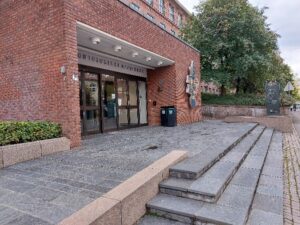 Entrance of the Institute of Clinical Dentistry © Friederike Götz
|
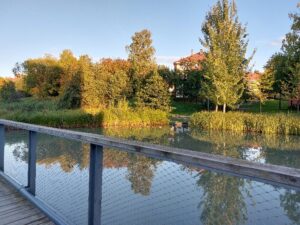 Pond right next to my flat © Friederike Götz |
Financial considerations
The cost of living in Oslo, as in all of Scandinavia, is quite high. My room rental was only two-thirds covered by the Erasmus+ funding, and the costs for daily needs such as food had to be paid on top of this, of course. At first I was a bit shocked by the prices in the supermarkets, which were sometimes twice (or even more) as high as in Germany. I didn’t go to restaurants often, which would have been even more expensive, and I didn’t buy alcohol – thanks to the high taxes on alcohol (and sugar) in Norway. But I have also found some ways to save money in everyday life: In the supermarkets, “Tilbud” is the word that indicates special offers. The weekly offers are often already sold out at the beginning of the week, but if you have the opportunity, it is worth taking it and getting groceries as well as cosmetics and other products much cheaper. Another insider tip is Grønland Frukt Og Grønt (located in Smalgangen 2), a shop where you can buy fruit and vegetables, but also spices and other foodstuffs at reasonable prices.
Free time in Oslo
At the beginning of the internship, the weather was still quite nice and I often explored the city after work and at the weekends. I had a student travel ticket that allowed me to drive all around the city and explore the city centre, the many parks, the harbour and lots of other sights. Since I love sports and play tennis in Germany, I didn’t want to give it up in Oslo either. There was a Facebook group to find tennis partners – which I made use of. Since the court rental was quite expensive, I often played in the morning before work, because then the prices – especially for students – were considerably cheaper. Although my institute had a small gym that I could use, I signed up for SiO Athletica, the student organisation gym that has several locations all over the city. I participated in some courses and on Sundays sometimes in walks that started in Kringsjå, the part of Oslo where the largest student housing is located. There is a beautiful lake there called Sognsvann with many hiking trails around it.
As my internship progressed, the days became noticeably shorter and the weather no longer invited me to spend too much time outside. These times were perfect for sauna visits. Together with some colleagues and friends, I booked a private group sauna that swam in the Oslo Fjord, with a beautiful view of the opera and the possibility to jump into the fjord if it got too hot inside.
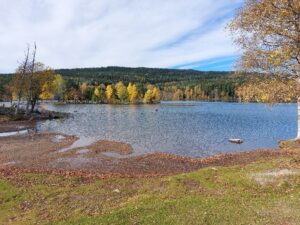
Sognsvann © Friederike Götz
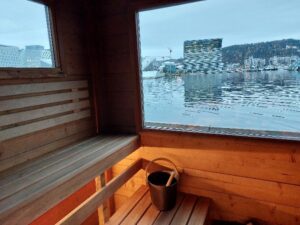
Sauna in the Oslo Fjord © Friederike Götz
Our weekend trip to the Nærøyfjord
One weekend, I went on a trip to the fjord scenery of Norway together with some of my internship colleagues. We rented a car (which was more difficult than expected, as we needed either a credit card or a Norwegian bank account, which neither of us had) and drove almost 8 hours to Voss, a municipality near Bergen. The drive took longer than expected because there was heavy rain that day and several times we came to places where a Norwegian stood next to a car with hazard lights on in the dark in the rain and told us that the road was closed and we had to take another route. In the end, we arrived at our accommodation right on the lake – which was now more or less in the lake, as our basement was flooded. Fortunately, the water had not damaged much and the upper floors were enough for us to sleep. So we were able to enjoy our weekend including an acquaintance with the unpredictable strength of Norwegian nature and a ferry trip on the Nærøyfjord, one of the two UNESCO fjords in Norway. The ferry went from Gudvangen to Flåm, a village famous for its railway, and was pleasantly empty as we were there outside the main season. Although the weather was not the nicest, the view was fantastic and I took many impressive photos that will always remind me of this unique experience.
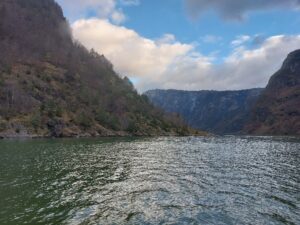
On the ferry in the Nærøyfjord ©Friederike Götz

View of the lake at our accommodation in Voss © Friederike Götz
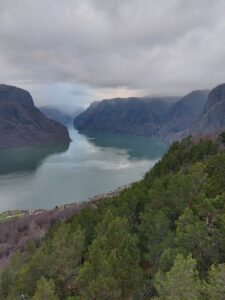
View of the Nærøyfjord from Stegastein viewpoint © Friederike Götz
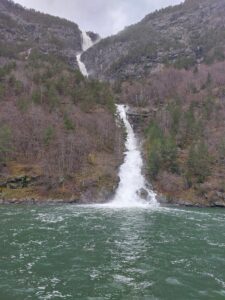
Waterfall in Nærøyfjord © Friederike Götz

